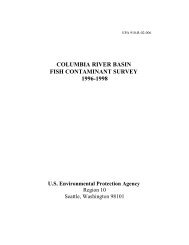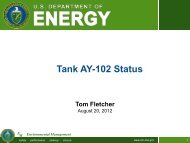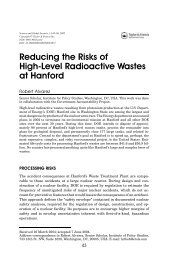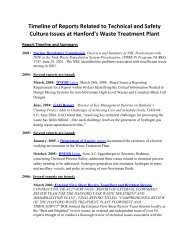Knowing Endangerment - Hanford Challenge
Knowing Endangerment - Hanford Challenge
Knowing Endangerment - Hanford Challenge
You also want an ePaper? Increase the reach of your titles
YUMPU automatically turns print PDFs into web optimized ePapers that Google loves.
II.<br />
BACKGROUND<br />
A. <strong>Hanford</strong> Tank Farms and Chemical Vapors<br />
High level nuclear waste (HLW) is recognized as one of the most dangerous substances known to<br />
humankind. It is created by processing irradiated nuclear reactor fuels in chemical solutions to<br />
recover plutonium for weapons production. In addition to being radioactive, HLW contains over one<br />
thousand chemicals. One Dixie cup full of HLW, placed in a crowded area such as a theatre, could<br />
kill nearly everyone within minutes. 2 The <strong>Hanford</strong> Nuclear<br />
Reservation (<strong>Hanford</strong>) stores 53<br />
million gallons of HLW in 149<br />
single shell and 28 double shell<br />
underground carbon steel storage<br />
tanks, ranging between 55,000<br />
and 1,000,000 gallon capacity<br />
and arranged in 18 groupings<br />
called „tank farms.‟ The HLW<br />
stored at the tank farms is<br />
chemically complex, due to the<br />
various reprocessing techniques<br />
and the wide array of substances<br />
added to the tanks over the<br />
years. 3 When irradiated fuel was<br />
reprocessed only shortly after<br />
irradiation, its waste liquid<br />
contained heat-generating<br />
radionuclides that made the<br />
waste so thermally hot that it<br />
would periodically burst into a<br />
violent surging boil that<br />
pressurized the tanks by<br />
releasing gases more than 20<br />
times the normal rate. Water<br />
was added to cool the waste. 4<br />
These various additions and the synergistic effects of the organic and inorganic chemicals and the<br />
radiation have transformed <strong>Hanford</strong>‟s HLW into a veritable “witches brew” of toxins. The waste in<br />
each tank forms varying mixtures of liquids and solids, including thick sludge, a dry, crystallized<br />
“saltcake,” liquid, and vapors. The tanks have to be monitored constantly. Probes detect leaks and<br />
measure temperatures, liquid levels, and other parameters associated with tank monitoring. There are<br />
risers that penetrate the tank dome and surrounding areas, and several process and service pits (called<br />
pump pits) are associated with the tanks. The pits are covered with heavy cover blocks and sealed<br />
2 Robert Alvarez, The Legacy of <strong>Hanford</strong>, THE NATION, Aug. 8, 2003, 31 – 35.<br />
3 Roy E. Gephart, Pacific Northwest National Laboratory [hereinafter PNNL], HANFORD: A CONVERSATION ABOUT<br />
NUCLEAR WASTE AND CLEANUP 5.16 (2002).<br />
4 Id.<br />
4







